The software development industry isn’t immune to change. It’s one of the most dynamic industries, and the State of Software Development 2021 report is a testament to the trends and changes it has undergone this past year.
No doubt, 2020 was a year of unparalleled disruption for everyone. The pandemic upended every industry, and businesses worldwide had to develop new ways–and sometimes improvise–to connect with their employees and customers to stay afloat. The world saw the rapid proliferation of remote-first work environments, and countless organizations underwent digital transformations that usually would’ve taken months in a matter of days. For the software development industry, this past year brought new, more urgent reasons to evolve faster. Developers had to find new ways to help organizations digitally engage with their employees and their market. Software development teams became the backbone of the new COVID-driven way of life. They found new ways to help businesses become more agile and produced new ways to code, build, and deploy digital products faster than ever before.
Many of these changes accelerated by the pandemic triggered new trends and remodeled the software development landscape for upcoming years. For this reason, it’s crucial to track, analyze, and learn from these changes. Additionally, it’s critical to gather this data, organize it, and use it to make educated guesses about the future, which helps developers mold their processes and adapt to upcoming shifts.
To bolster this process, Coding Sans, a Hungarian development agency, released their yearly State of Software Development report and has been doing it since 2018. As we entered this new year, they released their 2021 report with updated trends and insights to help the industry reflect on the pandemic’s impact, compare new data against past reports, and help developers keep up with our constantly evolving landscape. It’s also an opportunity to improve our practices in search of higher standards and hopefully build a more resilient future for our industry.
Here’s Foonkie Monkey’s overview of the Coding Sans State of Software Development 2021 report.
Top Challenges in Managing Software Development
In the 2021 report, Coding Sans found that hiring talent became the biggest challenge in software development, followed closely by capacity. Compared to past reports, where capacity took the prize as the top concern in 2019 and 2020, developers find it hard to hire qualified developers for their workforce this year.
Interestingly enough, a study from LinkedIn found that programming is the fastest-growing skill since the pandemic hit. People are learning and educating themselves on digital crafts at record rates, which has increased the available talent pool in the development sector. This phenomenon could mean that a growth in the talent pool for development companies to hire is on the horizon, which hopefully will be reflected in next year’s report. However, despite this year’s pandemic-driven downsizing, it’s encouraging to see that some development companies are still hiring.

As far as capacity goes, it is always a top challenge. We can see it ranking first in both 2020 and 2019 reports. Bringing in more developers is an apparent solution for these capacity issues, so hiring talent became a pressing challenge this year.
Additionally, knowledge sharing sank to third place, and prioritizing development dropped to fourth after being on the top three concerns in last year’s report. Surprisingly, time management didn’t change much compared to previous years, and employee retention rose, probably due to the new hybrid work environments.
• Overcoming the challenges
Building a brand and advertising more are the top two methods participants use to minimize hiring concerns. It is crucial to attract qualified developers because it defines a clear value proposition and work culture that will make them want to work with you and stick around. On the other hand, advertising gives you and your company visibility, which helps the world see who you are and what you stand for.
Responders also stated that outsourcing and recruiting more talent are two of the most effective ways to increase overall development capacity. However, these observable hiring issues make us wonder whether this is an effective solution for increasing capacity. Moreover, improving processes, such as implementing DevOps and other agile methodologies, is an excellent way to streamline workflows and increase capacity while prioritizing development.
• Manager vs. developer comparison
It’s no surprise that managers find hiring the biggest challenge. Instead, developers consider that sharing knowledge is a far more critical concern. Moreover, capacity and prioritizing development are roughly equally crucial for both managers and developers, while the latter consider time management a far more pressing concern. This phenomenon is once again a testament to the pandemic’s effects on communication and consistency of some work environments.
Covid 19’s Effects on the Development Industry
This section of the report is crucial to comprehend how the pandemic has modified the industry and the new challenges that came with it. Over half of responders claimed the pandemic didn’t affect their company. Of those not impacted, 20,92% said they saw no impact, and almost 33% claimed its negative and positive effects evened out, meaning they felt no significant change to their day-to-day operations. On top of that, the amount of companies positively impacted by Covid-19 is roughly equal to those that underwent negative changes. Additionally, about two-thirds of responders claimed they weren’t forced to downsize due to the pandemic.

From these numbers, we can confidently conclude that, before the pandemic, most development companies were either already implementing a remote work environment or were successful at hurriedly setting one in place. The fact that so many companies didn’t need to fire employees to survive means that the development industry is still standing strong, although not untouched by the pandemic.
• Remote Work During the Pandemic
One of the most significant shifts brought on by COVID-19 is making a partial or complete transition into remote work. Almost all companies surveyed in the report allow or expect their workers to work remotely. For some years now, the development industry has seen an increase in remote work, but this year we have witnessed a rise of almost 87% compared to pre-pandemic times.
Additionally, Coding Sans’ report shows that a staggering 97.9% of companies allow remote work instead of the conservative 74.92% observed in 2018. Also, only a tiny percentage of responders don’t implement remote work, and most companies are planning to switch to a hybrid model at some point. These numbers mean that remote work isn’t just a trend or a necessity, it’s an asset, and hopefully, it’s here to stay.
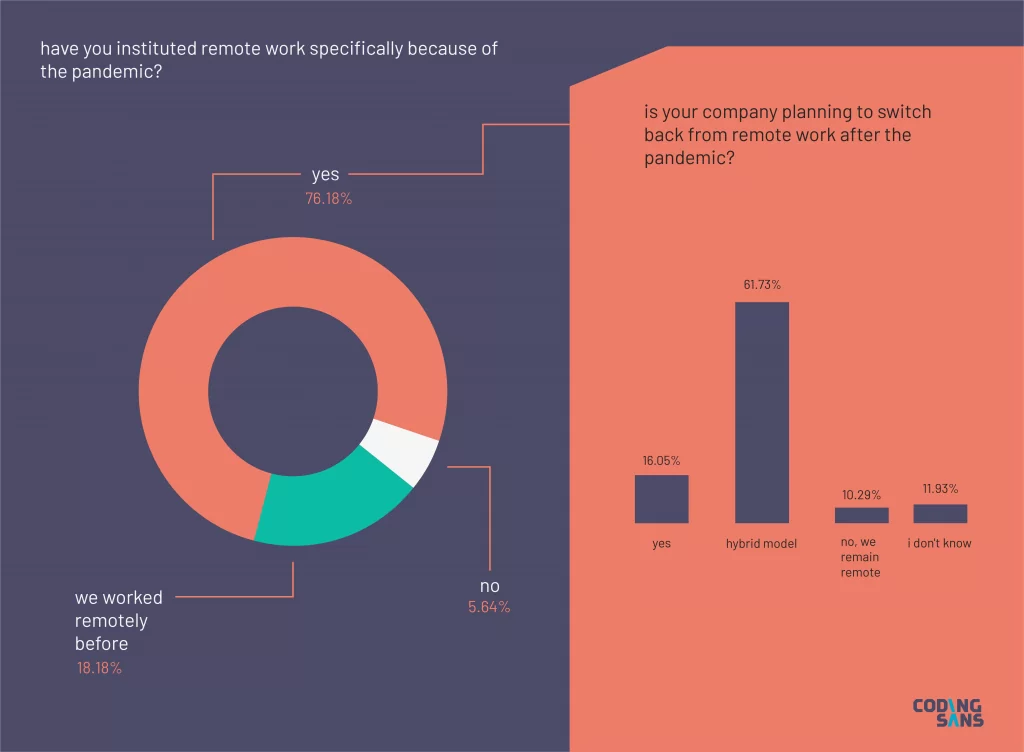
• Challenges brought by the Pandemic
Difficulties with communication
The forced remote work environment was the primary catalyst of the lack of communication and broken personal connections that concerned developers this year. Working at a distance creates communication barriers that make rapport between co-workers and management more difficult. Lack of water cooler conversations, asynchronous communication, and a lack of personal touch are some reasons why the industry witnessed a decrease in employee retention. Remote communication has also made additional meetings necessary, which reduces the time developers spend doing focused work.
At Foonkie, we’ve managed to successfully maintain a fully remote work environment for several years now. We always strive to enhance communication channels between co-workers and management by creating a remote work culture that encourages conversation and interaction whenever possible. It’s no easy feat, but it’s doable and worth it with the right tools and practices.
Work-life balance
Separating personal life from work is one of the most challenging aspects of working remotely. Developers claim to have a hard time focusing on work and that the distractions at home create an environment where they can’t concentrate and end up putting in extra hours, jeopardizing their wellbeing, rest, and free time.
More stress, burnout, and depression
Both points exposed above seem to be triggering extra stress, burnout, and depressive states in some of the responders on the report. The most concerning part of this phenomenon is its reduced visibility due to employees being far from each other. There’s no conversation about these concerning situations, which means managers and companies must stay on top of their employee’s mental health even when working at a distance.
Tools and Tech Trends
The most interesting and relevant section, the tools and tech trends part of the report, gives us insight into the most popular programming languages and tools developers use for testing, project management, version control, and communication. All the data and trends exposed in this section are vital because they help establish industry-wide standards, future trends and identify pain points and challenges when using specific tools.
• Programming Languages
For three years in a row, JavaScript remains the top programming language by far, even with a slight drop this year when compared to 2020. Java has been dropping considerably since 2019 but remains second while TypeScript takes the third spot and keeps growing, even surpassing Python, after being low on the list in 2019. On this point, and interestingly enough, when respondents were asked if they were considering using new programming languages in the next 12 months, almost 20% said they were considering TypeScript. From this figure, we can safely conclude that TypeScript promises to become an essential language and possibly the most used one in upcoming years. Lastly, to that same question, 32.45% of developers answered that they were not interested in trying a new language.
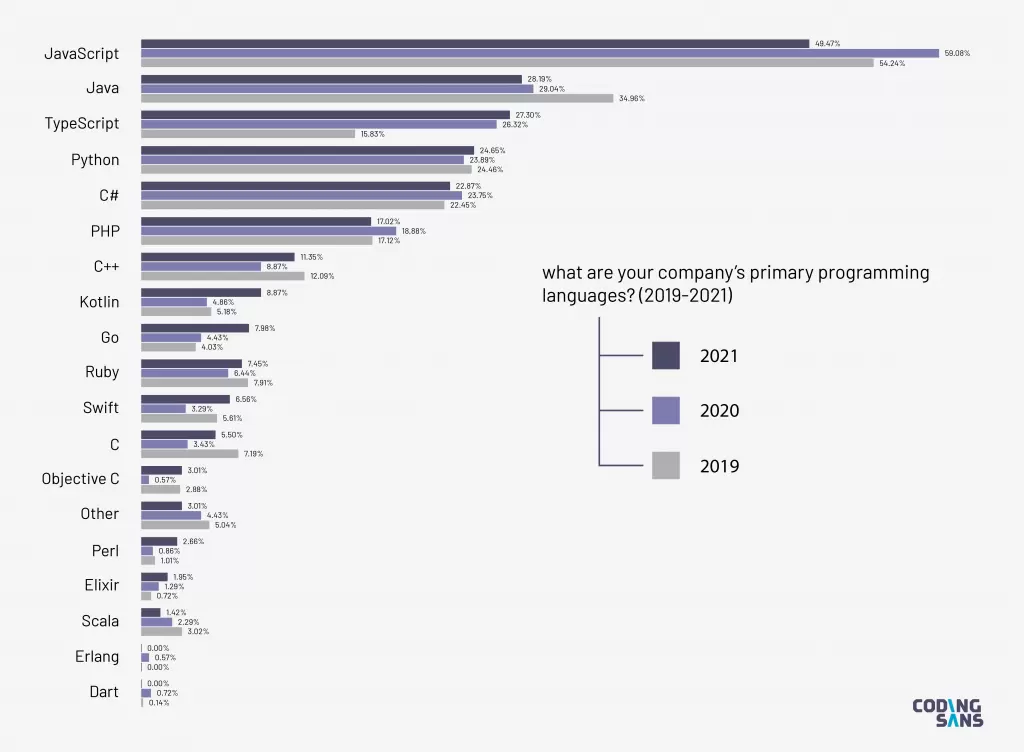
• Tools
The testing tools category is ruled by Selenium, with Jest as a close second and JUnit as a distant third. On the other hand, project management tools are led by Jira by a large margin, followed by a close race between Trello, GitHub Projects, and GitHub Issues, with Trello stepping up significantly from previous years. GitHub.com conquers the version control system category while VSCode and Microsoft Visual Studio lead the Integrated Development Environment (IDE) arena.
Email and Slack remain at the top of the communication tools category, with the latter dropping to second place this year but still maintaining a high usage percentage. Zoom and Microsoft Teams blew up this year and have shown the most impressive growth, jumping from 2.3% in 2019 to 30.87% and 5.6% to 40.2%, respectively. This massive hike seems to be propelled by the pandemic, and we will likely see them become more prominent trends and rank higher on next year’s report.
For us at Foonkey Monkey, this point is especially critical due to our fully remote workforce. Having good, competent communication channels and tools lays the groundwork for an efficient and compact development team. These tools bring priceless benefits to the table in terms of collaboration and teamwork, which is why they are non-negotiable assets if you’re enforcing a remote work environment.
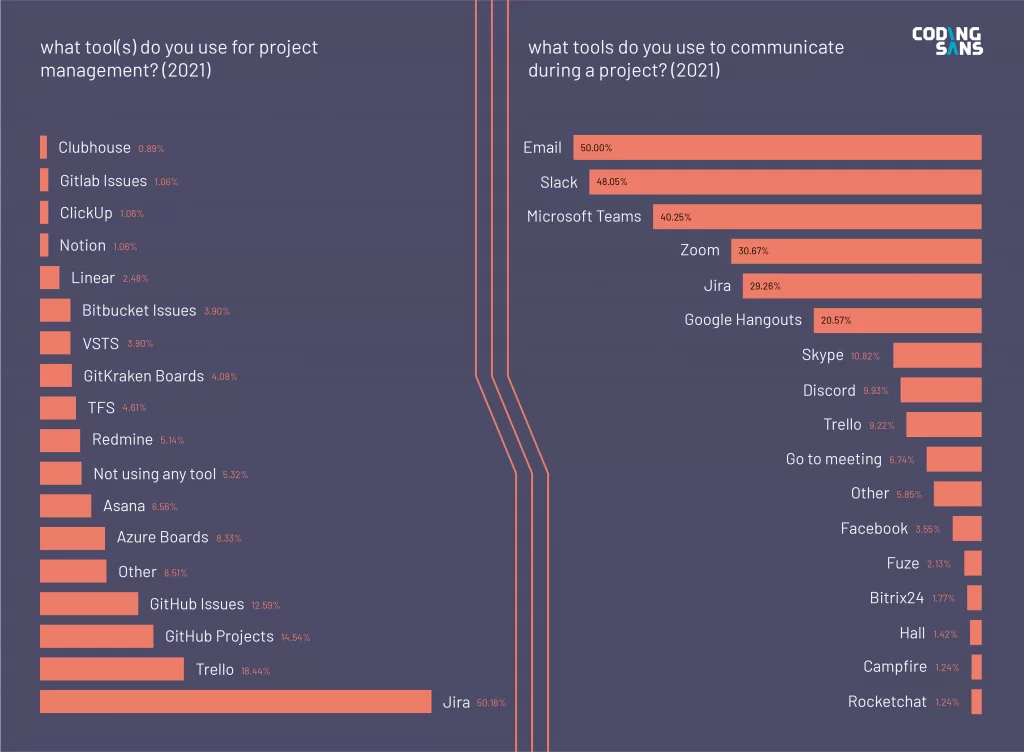
Hiring Talent
As we explained earlier, hiring talent has become the top challenge for the development industry, especially this past year. Employee retention, communication, and motivation became issues after the transition into remote environments. Coding Sans wanted to help the industry understand and learn more about how development companies deal with these issues.
As we can observe in the data from these past three years, hiring methods haven’t changed much. Employee referrals remain the most popular method, but we see an emerging trend in hiring via LinkedIn and professional connections. Although not high enough to be considered a substantial rise, it’s worth noting that these two hiring methods may become future trends.
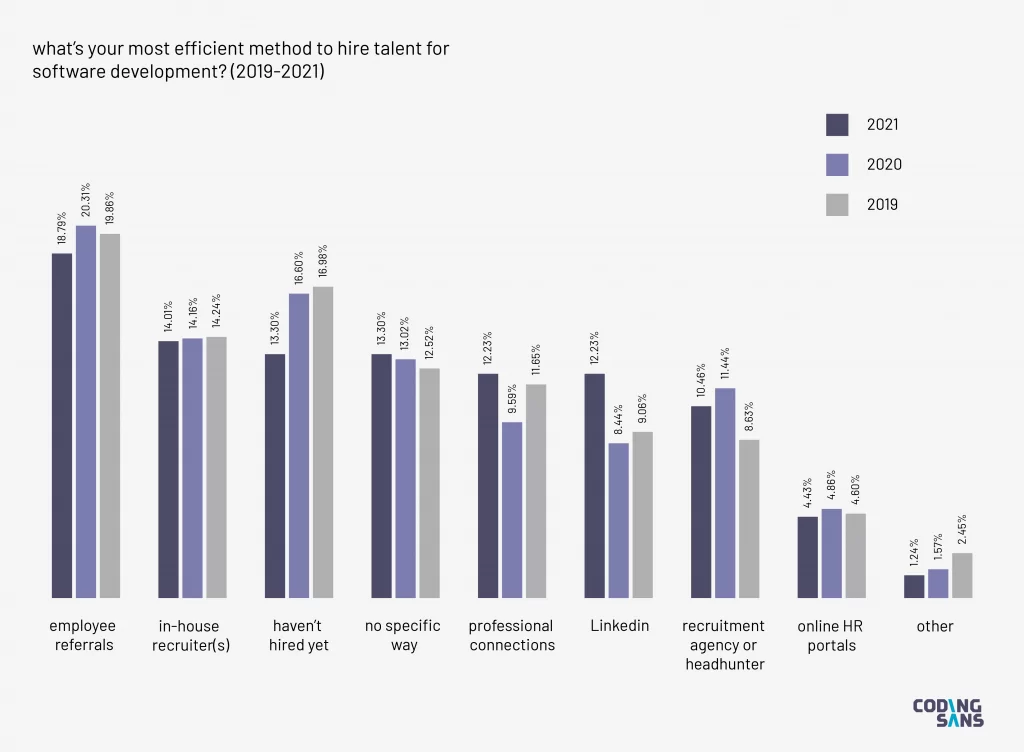
On the other hand, willingness to learn is still the most relevant hiring criteria for development companies, followed by cultural fit as a far second. Surprisingly, work experience has been swinging between third and fourth place these past years, meaning managers aren’t looking at any specific experience as a top hiring benchmark. We find it encouraging that cultural affinity and willingness to learn are more critical hiring criteria than experience.
Lastly, we see that development companies transmit a teamwork-oriented environment to attract new talent. It is followed closely by allowing growth opportunities, giving developers engaging and challenging tasks, and enabling flexible working hours. Moreover, to keep employees motivated, they chose teamwork, autonomy, and engaging tasks over money and extra benefits, meaning that managers don’t see money as a top way of incentivizing and retaining talent. This is encouraging, especially for startups that can’t afford to give monetary incentives but must keep their employees motivated.
As we at Foonkie know all too well, these are all effective strategies for development companies of all sizes to not only attract new talent but avoid turnover and keep employees happy and incentivized.
Outsourcing Developers
For a while now, outsourcing has been a common practice for development companies to cut hiring costs and tackle capacity issues, which, as we already discussed, is an industry-wide concern. We had already witnessed an increase in outsourcing practices in the sector, with a rise of 13.6% in outsourcing expenses for the IT sector compared to previous years. Added to these figures, Coding Sans reported a 4% increase in the number of companies that outsource compared to last year’s. It may not seem like much, but a steady growth could indicate an upcoming upward trend and, hopefully, a future where outsourcing is commonplace for the industry.
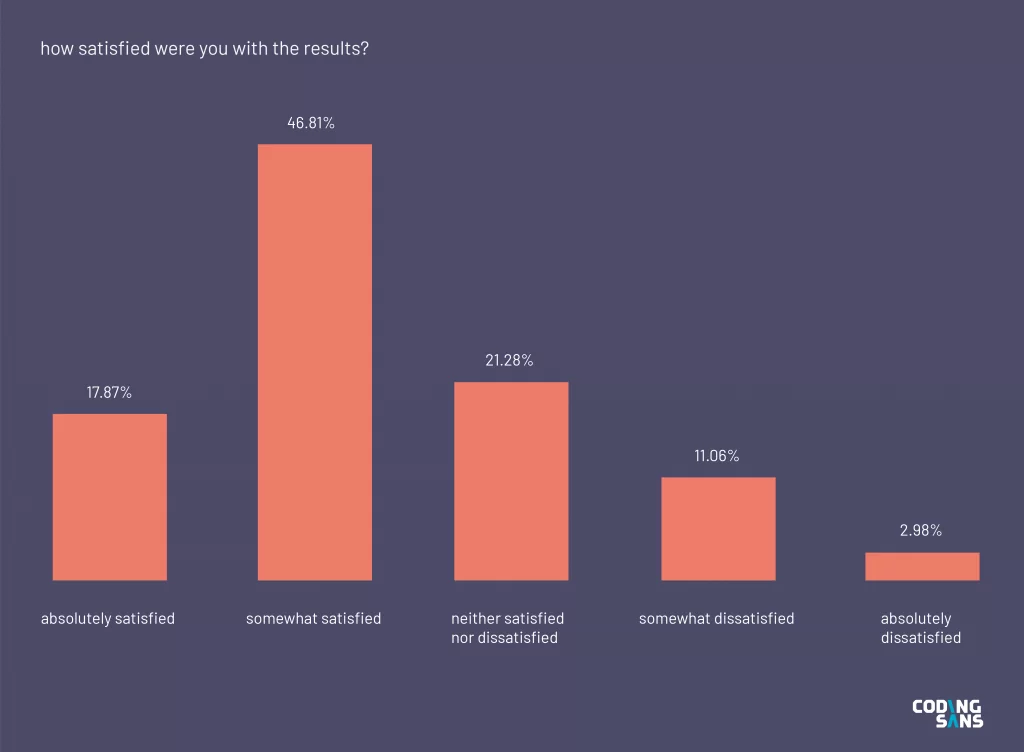
Furthermore, the report shows that, out of the respondents who engaged in outsourcing, only 3% found it dissatisfying. The vast majority of development companies found working with outside contractors satisfying or somewhat satisfying, which indicates an overall joyous embrace of the outsourcing experience. However, when asked if they were planning to outsource software projects in the next 12 months, almost 70% of companies said no, and only 7.6% said yes.
Performance Measurement
This section digs into how development companies measure their developers’ efficiency, performance, and delivery rates and issues. Performance measurement is crucial because it helps differentiate between top and average-performing teams and establishes a benchmark for competitive companies. It also allows companies to identify pain points and flaws and correct them to increase efficiency and improve delivery rates.
The report concluded that the top two metrics used to measure developer performance are working software and completed tasks. Surveyors compared these metrics between the top and average-performing companies and found that a more significant number of top-performing companies put more emphasis on them. They also found that top performers find code readability a more relevant performance indicator, which makes sense since high-quality code is easier to maintain and is less likely to lead to technical debt. It’s important to note that technical debt is one of the leading causes of inefficiency, wrong code, and product defects, and it costs development companies around $85 billion annually to fix.
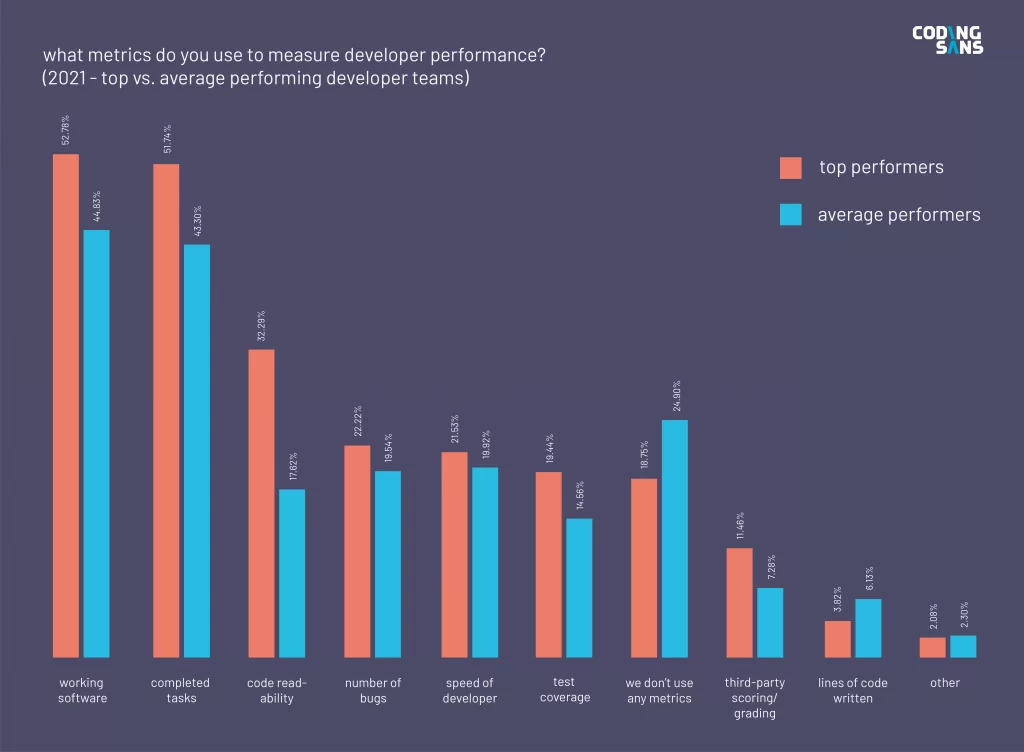
Top performers also measure the success of software development managers by using two criteria: working software and on-time delivery.
On the other hand, average performers use the top two metrics exposed above. Still, they are also more likely not to use any metrics, creating problems when evaluating processes and employees. They also tend to measure the success of software development managers by observing working software rates. However, most of them don’t have any particular criteria in place for this type of tracking.
• Delivery Problems
As far as delivery problems go, the industry consensus falls on the lack of clearly defined deliverables followed by unrealistic expectations and estimations as a close third. Managers and developers, however, have different opinions on delivery problems. Managers consider the lack of clearly defined deliverables as a leading cause of delivery issues, while developers think estimation miscalculations are the reason for said problems. Managers are also more concerned with budgetary restraints and unrealistic expectations. On the other hand, developers consider that wrongfully prioritizing requirements and a lack of team experience are at the root of complications with delivery.
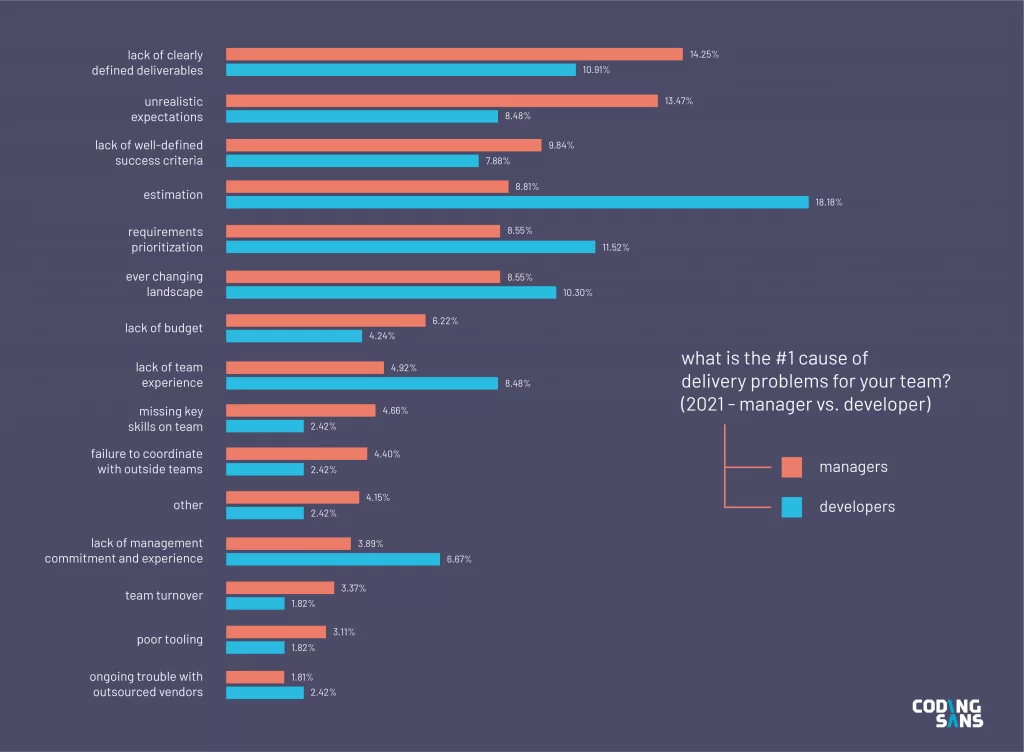
Much of these differences between managers and developers are closely related to each job’s differing responsibilities and tasks. However, we think managers must allocate more effort to understand their team’s concerns. Finding common ground is a fail-safe strategy to establish communication channels and help managers tackle any problems that may be troubling an underachieving development team.
Lastly, in the case of delivery problems for top and average performers, Coding Sans found minimal differences between both. Top performers are more likely to focus on estimation, unrealistic expectations, and a lack of well-defined success criteria. On the other hand, average performers tackle challenges such as lack of clearly defined deliverables, lack of sufficient budget, and lack of experience.
About the Survey
Coding Sans’ State of Software Development 2021 report surveyed 564 respondents, all of the professionals from the software development industry. Most of those 564 respondents sell to other businesses (B2B) and are based in Europe, although a large percentage are from North America. Most respondents, 32.98% to be exact, are in the software development industry, followed by the IT services industry and the financial services sector as a distant third. Additionally, almost 30% of the surveyed enterprises have more than 200 employees, and out of all the 564 respondents, nearly 30% were developers.
• Partners
To put together this report, Coding Sans carried out an online survey in cooperation with the following partners:
- GitKraken Git GUI
- Clutch
- CooperPress
- Level-up Engineering
- Meetupfeed
- Apiumhub
- Coder.com
- Dashbird
- ServerlessGuru
- Storyblok
- Webiny
The survey took place from February 2021 until April 1, 2021, and consisted of thirty-five questions sent via email, social media, and newsletter.
Final Word
Reports such as the one discussed in this article are crucial for the development industry to reach new standards and keep striving for better, more efficient processes. We must keep gathering data and insights on how our industry evolves and transforms through the years. Gaining the necessary experience to reshape our industry depends mainly on analyzing these datasets and producing knowledge to make informed decisions about the future. These reports are valuable tools to accomplish that and keep track of the trends that will undoubtedly continue to make us the carriers of the digital torch.
This article is just a small overview of the valuable data collected by Coding Sans. If you have any further questions about the report or any other aspect of our work, we’re just an email away!
